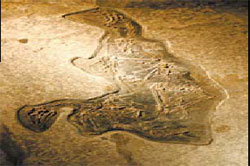| Tools: Save | Print | E-mail | Most Read |
| Fossils Fuel Thrills at the Museum |
| Adjust font size: |
Entombed in two slabs of fine-grained rock, a skeleton of a bird-like creature with a long tail caught my eye as soon as I entered the Sihetun Geology Museum in Beipiao City, about a one-hour drive from Chaoyang. Not far away, on a rock slab about 20 meters long and 12 meters wide lies the skeletons of four small dinosaurs and 20 Confuciusornis, a genus of a crow-sized prehistoric bird from the Early Cretaceous period of China, approximately 120 million years ago. "We keep the fossils at the place where they were discovered," said Wang Yaozhong, a staff member from the museum. Standing in the middle of the hall I felt a bit weird. What do we do if these creatures come alive like the dinosaurs in Steven Spielberg's Jurassic Park? Fortunately, they are not as big as the dinosaurs in the movie. The hall of the museum descends about 14 meters underground where geological movement is shown in the rock layers. It was built on the original site where the scientists found the fossils. Also on display at this 600-square-meter museum are fossils of insects, turtles, fish and flowering plants. They all belong to the Jehol Biota Group. The western part of Liaoning Province is known as Jehol Biota as it used to belong to Jehol Province in the early 20th century. It became famous when fossils were found there in the 1920s. From the late 1980s, the fossil beds drew many scientists after the discovery of a 120 million-year-old bird fossil Sinosauropteryx. It was the first dinosaur discovered that had primitive feathers. Since then several new species of dinosaurs with feather-like structures have been found on the fossil beds, including the Confuciusornis and Protarchaeopteryx. Up to now, more than 250 fossils of different birds have been unearthed there as well as a number of fish, insect and plant fossils. The studies on the Jehol Biota show that, 120 million years ago, the western part of Liaoning used to be a scenic place with lakes and dense forests filled with dinosaurs, birds, fish and various prehistorical creatures. A sudden volcano eruption buried them, preserving them as they were at that moment. The studies also revealed patterns and processes of the evolutionary radiations of many major groups of Early Cretaceous animals and plants, such as the earliest known radiation of angiosperms and birds, early differentiation of mammals and many Cretaceous dinosaurian groups. In 1998, the government established the Beipiao Nature Reserve for the Bird Fossils. The reserve covers 46 square kilometers and is patrolled by a staff of 40 guards. Visitors are not allowed to touch the fossils. Before leaving the museum I found a small piece of slab by the rock layer. Although there was nothing on it, I got Wang's permission to keep it. "I'll take you to the mountains when you come next time," Wang said, "you might find some fish fossils." (China Daily March 7, 2007) |
| Tools: Save | Print | E-mail | Most Read |
 |
| Related Stories |
|
